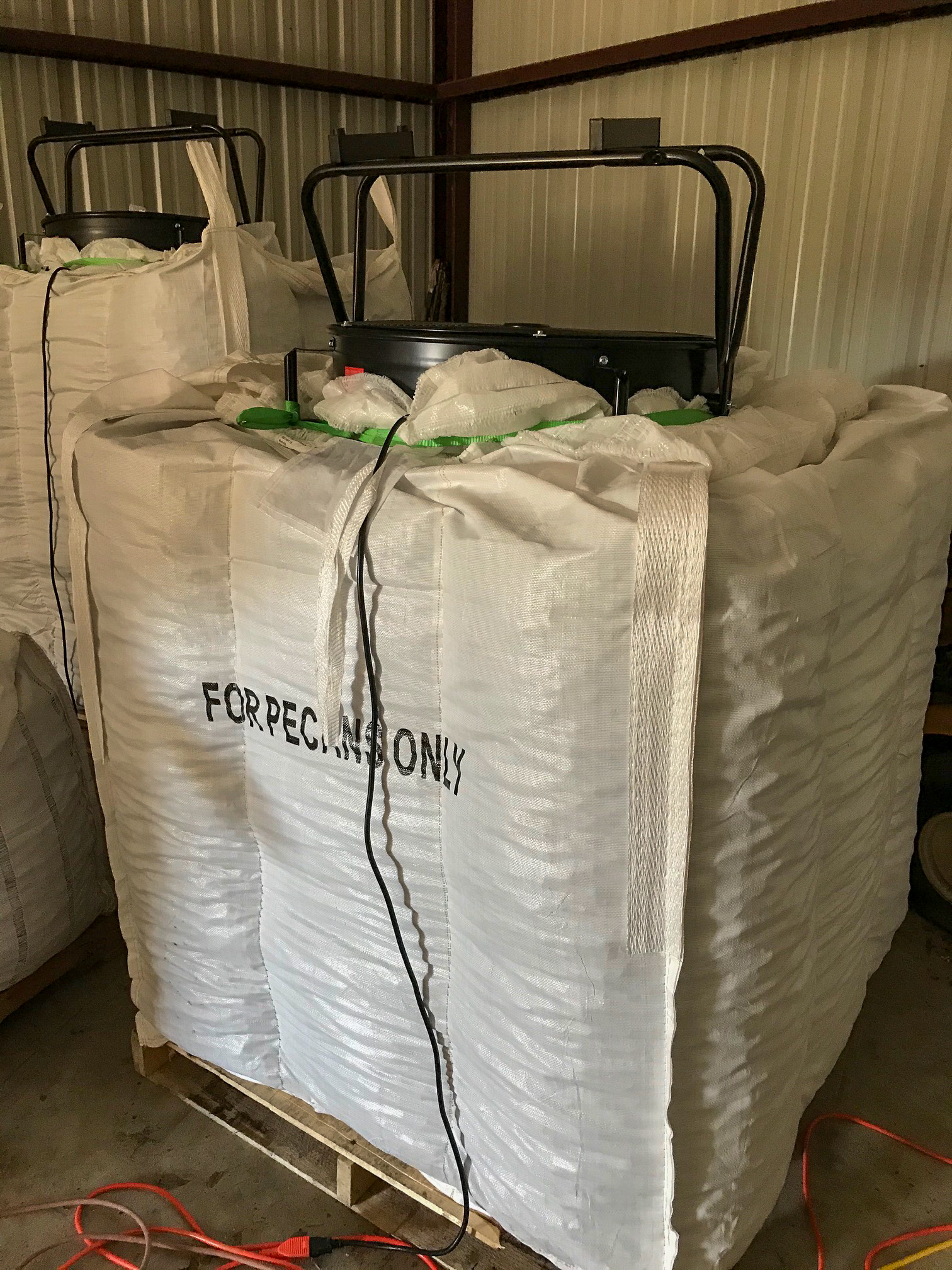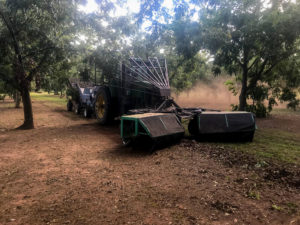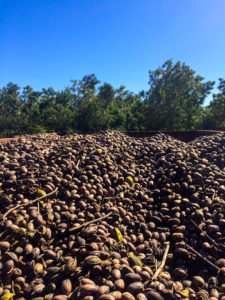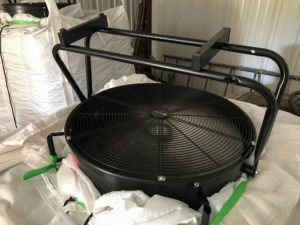Protecting pecan quality through and beyond harvest

Floor fans blow air into super sacks full of inshell pecans. Although this is a rudimentary way of drying pecans, it may be useful for those who can't afford or don't have access to commercial dryers. (Photo by Lenny Wells)
The next race to preserve pecan quality begins when the nuts fall from the tree. No matter which phase of the process you may be involved in going forward, maintaining crop quality comes down to managing two key factors—temperature and moisture. Pecans do not like either of these factors to get too high, and when exposed to such conditions for too long, kernels will turn dark as the tannins in the seed coat oxidize. Under extreme circumstances, mold can develop and the nuts can turn rancid.
Most growers in our region shake trees twice during the harvest season if the trees are carrying a good crop. Some refer to the first shake as a “green shake.” This normally occurs when at least 80 percent of the shucks are open. Though there is an additional expense to harvesting twice, most growers feel it is justified if they can get higher prices on the early market.
With the first shake occurring this early, temperatures are often warm and humidity can be high. Of these two factors, temperature can be the most problematic with early harvest. It is not unusual to see temperatures in the 80s well into November. If this occurs under high moisture conditions in the shucks, sprouting and embryo rot can be an issue. But, late harvest is not without its own obstacles.
Once December arrives, we usually see an increase in the frequency of rainfall, which puts the nuts at risk of quality degradation. One of the most frustrating situations to be in during harvest is to have nuts swept into a windrow awaiting harvest that get rained on before the harvester can pick them up. Nuts can mold quickly in a wet windrow so growers must take immediate action.
If it is only light rain, windrows can be flipped with a sweeper and will be able to dry if the rain is gone and the sun is out. If the windrows are soaked through by heavier rain, they will have to be blown out again so that air can get to the nuts. Additionally, the longer the nuts stay out on the ground, the greater risk of predation and, increasingly in today’s world, theft.
The key to avoiding many of these problems is a timely harvest. Shaking early may require the nuts to lay on the ground for a day or two before harvest. This helps to dry the nuts out naturally. When shucks first begin opening, the nuts may have a moisture content as high as 20 to 30 percent. When the air is dry, this moisture drops quickly in the newly exposed nuts to around 8 percent. Some nuts can fall to the ground naturally at this point, and many nuts shaken from trees while the shucks are still green will be in the 8 percent moisture range when they hit the ground. Cracking these nuts will sometimes reveal the kernels to be “gummy” in texture and lacking the golden color and crispness of a mature kernel. A couple of days on the ground in dry weather usually gets the moisture down to around 6 percent. Harvesting nuts in the morning before the dew dries will only cause the moisture to rise from there.
As they are loaded into the wagons, nuts are taken to the cleaning plant for cleaning and further drying. The industry formerly dried nuts down to 5 to 5.5 percent moisture, which was considered suitable. With the advent of the export market, it was required to dry nuts down to 4 to 4.5 percent moisture so that kernel quality could better be preserved as the nuts journeyed overseas. Four to 4.5 percent is indeed the ideal moisture range to best protect the quality of the nut. As temperatures can be quite high along some of the routes by which nuts were shipped, most of the nuts destined for export were also placed into refrigerated containers, giving them the best opportunity to make it to their destination without losing quality.
Fully mature, freshly harvested nuts stored in woven bags under dry conditions and good ventilation can cure naturally in about two weeks, but under high humidity and a green harvest, additional measures must be taken. Drying nuts in wagons or bins with forced, often heated air dries the nuts down rapidly to between 4 and 4.5 percent, with the exact timing depending on temperature, humidity, nut moisture, and volume of the container used.
Commonly, unheated forced air blown at 90 cubic feet per minute will dry pecans if the ambient humidity is 70 percent. Since humidity can be much higher in the southeastern United States during the fall, the nuts should be dried faster by heating the forced air to 90 to 95 degrees Fahrenheit. Do not exceed 100 degrees F when drying pecans to avoid damage to the kernel.
I have also seen nuts dried in super sacks with a fan placed on top of the open super sack to pull the moisture out of the sack. While this is not the best scenario for rapid drying, it can work under the right conditions when this method is employed within a dried-in building if no other options are available.
If you are selling inshell nuts to a broker or sheller in bulk, once the inshell nuts are dried they should be stored in a dry building. Properly cleaned and dried nuts held in super sacks in a dry warehouse will be good for up to four months during the cooler months of the year. This timeline should be suitable for most growers selling to a broker or sheller. For extended periods of up to a year, inshell nuts should be stored in an odor-free atmosphere at 65 percent relative humidity at 32 to 36 degrees F. For periods longer than one year, inshell nuts should be stored at sub-freezing temperatures.
Many growers are now beginning to shell and market at least a portion of their own crop. In order to be successful at this, growers have to understand the proper conditions under which to store pecan kernels. The high unsaturated fat content of pecan kernels makes them particularly susceptible to degradation, and they must be handled properly to avoid quality loss. If not stored appropriately, these unsaturated fats will be oxidized, the fats will begin to break down, and the kernels will decline rapidly from that point. Once again, it’s all about temperature and moisture.
Inshell nuts generally store better than shelled kernel meats, and halves store better than pieces. Shelled kernels and pieces can be stored in an odor-free atmosphere at 65 percent humidity and 32 to 36 degrees F for up to 8 months. The smaller the pieces, the less time they will have before deterioration begins. Beyond 8 months, kernels must be stored below freezing to avoid excessive quality losses. Also, be aware that if you keep kernels in cellophane or non-breathable plastic bags at temperatures below freezing, you can get condensation on the nuts inside the bag as they thaw. This moisture inside the bag can contribute to deterioration and reduced shelf life.
Condensation inside food storage containers is normal. The additional moisture is not coming from the nuts themselves but from the water vapor in the air trapped inside the container as it is sealed. Water vapor tends to condense on the coldest surface first. When a container or package is moved to refrigeration, it cools from the outside in, making the container’s inside the coldest surface where condensation forms. You can minimize condensation by reducing the amount of air in the packages. Growers can reduce air by filling containers to the top or by use of vacuum packing.
Flushing packages with nitrogen also helps to preserve quality. Nitrogen flush packaging replaces the oxygen inside the package with nitrogen. Unlike oxygen, nitrogen does not react with food products or affect their texture or flavor. Thus, pecans will stay fresh for a longer period of time. Moreover, nitrogen flushing is a type of Modified Atmosphere Packaging method. The process can take place inside the container itself and in the various packaging steps, such as in the filling and sealing processes. Nitrogen gas is perfectly safe for this use. Bear in mind that you are constantly inhaling nitrogen every day as it makes up 78 percent of the atmosphere.
Protecting the quality of your crop after harvest is just as important as it is before harvest. If we are to continue growing demand for pecans throughout the world, we have to have a good, quality product. Proper handling and storage of pecans through harvest and beyond is key to accomplishing this goal.




